Reprimand letters are formal letters that employers use to address bad behavior or poor performance at work. These letters are important for keeping order and making sure everyone follows the rules.
What reprimand letters are, how they should be written, and provide examples to help you understand.
What is a Reprimand Letter?
A reprimand letter, also called a disciplinary or warning letter, is an official document given by an employer to an employee. It is used when an employee does something wrong or does not perform well at their job. The letter tells the employee about their mistake and warns them about what could happen if they do not improve.
Why Are Reprimand Letters Issued?
Reprimand letters are given to employees when they do something wrong at work. These letters help keep order and make sure everyone follows the rules. Here are some reasons why reprimand letters are issued:
Tardiness:
If an employee is often late to work, it disrupts the workflow and affects other team members.
Unprofessional Behavior:
Behaving inappropriately at work, such as being rude or not following workplace etiquette.
Policy Violations:
Breaking company rules, such as not wearing the required uniform or using company property for personal use.
What Should Be Included in a Reprimand Letter?
A reprimand letter should have all the necessary information to clearly communicate the issue. Here’s what to include:
- Date: When the letter is written.
- Employee’s Name: Who the letter is addressed to.
- Description of the Issue: Clearly explain what the employee did wrong. Be specific about the behavior or incident.
- Impact: Explain how the issue affects the team or the company.
- Previous Discussions: Mention any previous conversations or warnings about the issue.
- Expected Changes: Clearly state what the employee needs to do to improve.
- Consequences: Explain what will happen if the behavior does not improve.
- Signature: The letter should be signed by the supervisor or manager.
How should a reprimand letter be structured?
A reprimand letter should have a clear and simple structure. Here’s how to organize it:
- Heading: Include the date and the employee’s name.
- Introduction: State the purpose of the letter.
- Description of the Issue: Explain what the employee did wrong.
- Impact of the Issue: Describe how the problem affects the team or company.
- Previous Discussions: Mention any past talks or warnings about this issue.
- Expected Changes: Tell the employee what they need to do to improve.
- Consequences: Explain what will happen if the behavior does not change.
- Conclusion: End on a positive note, encouraging improvement.
- Signature: The letter should be signed by the supervisor or manager.
Here is a sample structure for a reprimand letter:
Heading
- Date: [Insert Date]
- To: [Employee’s Name]
Introduction
- Purpose: “This letter is to address [specific behavior or performance issue].”
Description of the Issue
- “You have been late to work several times over the past month.”
Impact of the Issue
- “Your tardiness affects the team’s productivity and causes delays.”
Previous Discussions
- “We talked about this issue on [dates of previous discussions].”
Expected Changes
- “You need to arrive at work on time every day.”
Consequences
- “If this continues, further actions will be taken, which may include suspension or termination.”
Conclusion
- “We believe you can improve and meet these expectations.”
Signature
- “Sincerely, [Your Name]”
What Tone Should a Reprimand Letter Have?
A reprimand letter should have a professional and respectful tone. Even though it is addressing a problem, it should not be harsh or rude. Here’s how to keep the right tone:
- Be Firm but Fair: Clearly explain the issue without being overly critical.
- Stay Positive: Focus on how the employee can improve.
- Show Respect: Treat the employee with dignity and avoid blaming or shaming.
Examples of constructive language
- Instead of: “You are always late.”
- Use: “There have been several instances of tardiness, which affects team productivity.”
Can a Reprimand Letter Be Challenged by the Recipient?
Yes, an employee can challenge a reprimand letter if they believe it is unfair. Here’s how they can do it:
Grievance Process:
Many companies have a formal process for employees to file a complaint if they feel they have been treated unfairly.
Provide Explanation:
The employee can explain their side of the story and present any evidence or reasons for their actions.
Seek Mediation:
Sometimes, a neutral third party can help resolve the dispute between the employee and employer.
What Are the Consequences of Receiving a Reprimand Letter?
Getting a reprimand letter can lead to several consequences:
Performance Review Impact:
A reprimand letter can negatively affect an employee’s performance review, which might impact promotions or raises.
Employment Record:
The letter becomes part of the employee’s permanent record, and it can influence future disciplinary actions.
Behavior Monitoring:
The employee’s actions might be more closely monitored by their supervisors to ensure improvement.
How Should an Employee Respond to a Reprimand Letter?
When an employee receives a reprimand letter, it’s important to respond in a positive and professional manner. Here are some steps an employee can take:
- Stay Calm: Read the letter carefully and take some time to understand it before reacting.
- Acknowledge the Issue: Accept responsibility if the reprimand is justified. It shows maturity and a willingness to improve.
- Provide an Explanation: If there were reasons for the behavior or if there’s been a misunderstanding, explain your side of the story.
- Plan for Improvement: Outline the steps you will take to address the issue and prevent it from happening again.
- Communicate with Your Boss: Have a discussion with your supervisor to show you are serious about fixing the problem.
Steps for Addressing the Concerns Raised
- Reflect on the Feedback: Think about the points mentioned in the reprimand letter. Understand what went wrong.
- Make a Plan: Write down specific actions you will take to improve. For example, if you were late, plan to leave home earlier.
- Follow Through: Stick to your plan and make the necessary changes. Show your boss that you are committed to improving.
- Ask for Help: If you’re not sure how to improve, ask your supervisor or a trusted coworker for advice.
- Monitor Your Progress: Keep track of your improvements and note any positive changes.
Can a Reprimand Letter Be Removed from an Employee’s File?
Yes, a reprimand letter can sometimes be removed from an employee’s file. Here’s how it can happen:
- Improvement Over Time: If the employee shows significant improvement, the letter might be taken out after a certain period.
- Request for Removal: The employee can ask for the letter to be removed. This usually happens after they have proven they have corrected their behavior.
- Company Policies: Some companies have specific rules about how long reprimand letters stay in an employee’s file. Check with Human Resources for details.
Long-term Impact on Employment Records
Reprimand letters can have lasting effects on an employee’s career:
Promotion Prospects:
Employees with reprimand letters in their records may find it harder to get promoted.
Job Opportunities:
Future employers may review the employee’s record and view reprimand letters as a negative mark.
Trust and Responsibility:
It might take time for the employee to regain the trust of their supervisors and colleagues, which can impact their chances of being given more responsibilities.
Common Mistakes and Best Practices
What Are Common Mistakes to Avoid When Writing a Reprimand Letter?
- Being Too Vague: The letter should clearly state what the problem is. Avoid using general statements.
- Using Harsh Language: The tone should be firm but respectful. Avoid words that might come across as rude or overly critical.
- Not Providing Specifics: Give detailed examples of the behavior or performance issue.
- Ignoring the Employee’s Perspective: Consider the employee’s side of the story and be fair.
- Lack of Follow-Up: Mention what will happen next and how the employee can improve. Follow up to ensure changes are made.
Tips for Drafting Effective Reprimand Letters
- Be Clear and Concise: Use simple and straightforward language. The letter should be easy to understand.
- Stay Professional: Maintain a respectful tone throughout the letter. Avoid getting personal or emotional.
- Include All Necessary Details: Make sure to cover what happened, why it’s a problem, and what needs to change.
- Offer Support: Show that you are willing to help the employee improve. Suggest resources or training if needed.
- Set Clear Expectations: Explain what you expect from the employee moving forward and what the consequences will be if the behavior doesn’t change.
Letters of Reprimand Examples
here is example of reprimand letters:
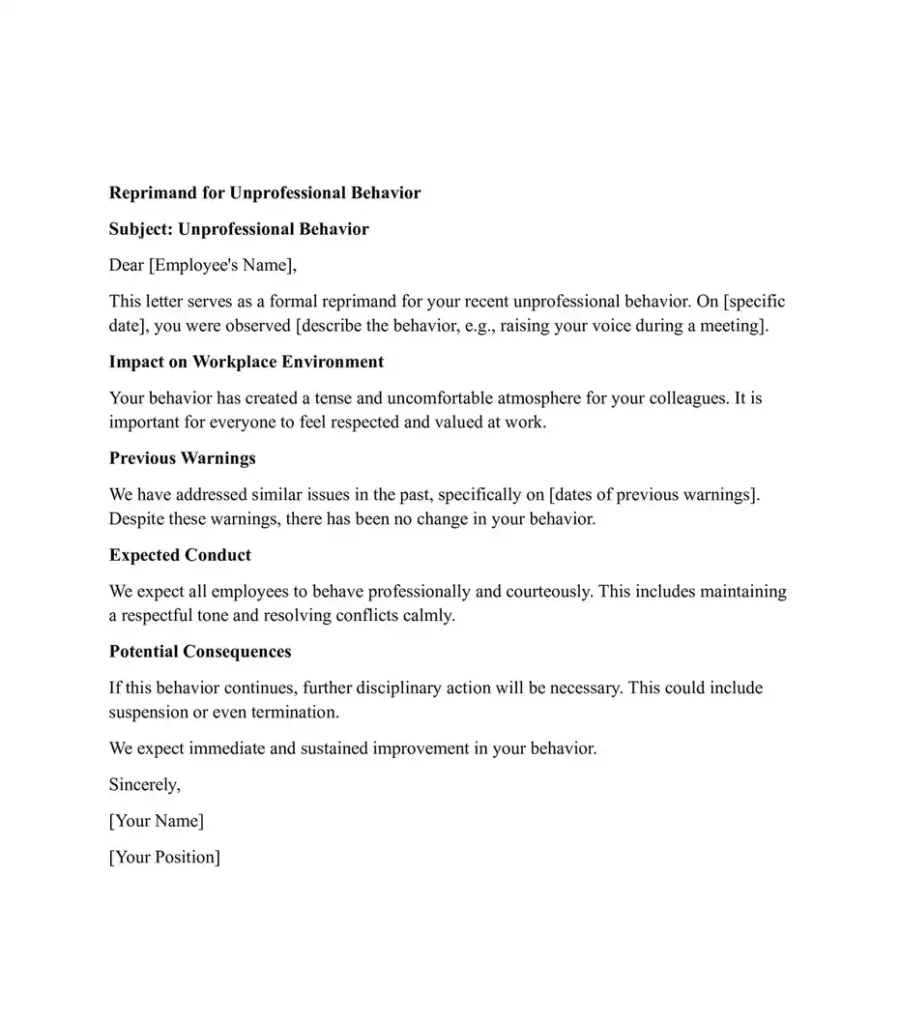
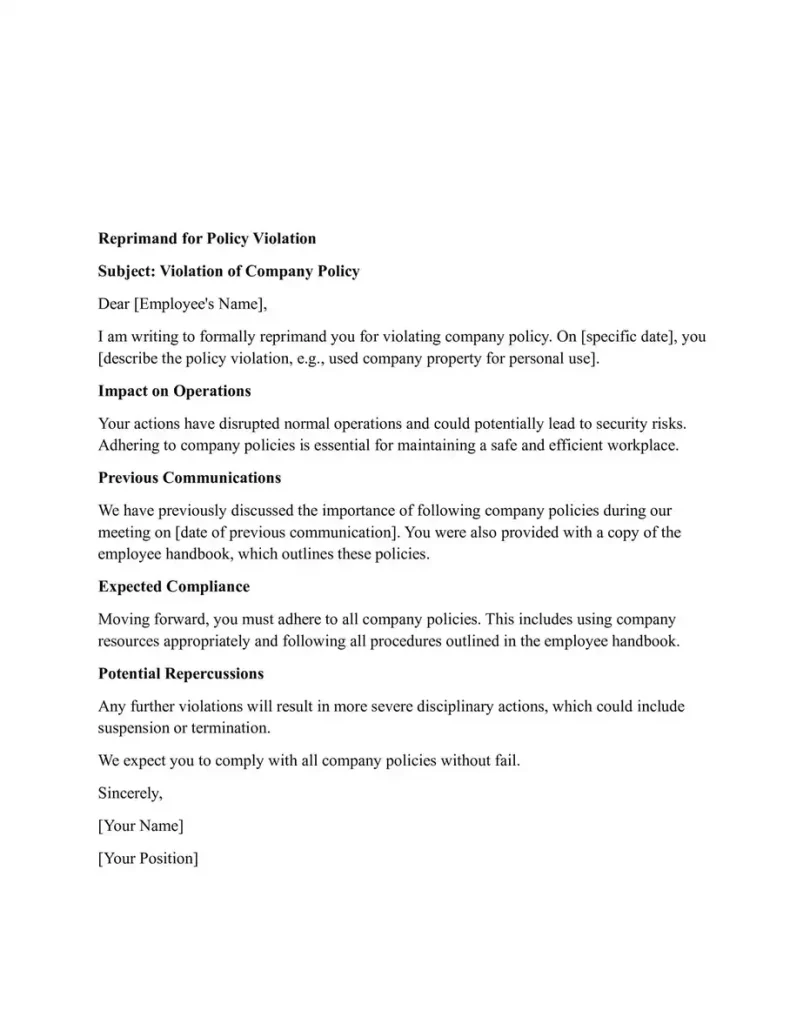
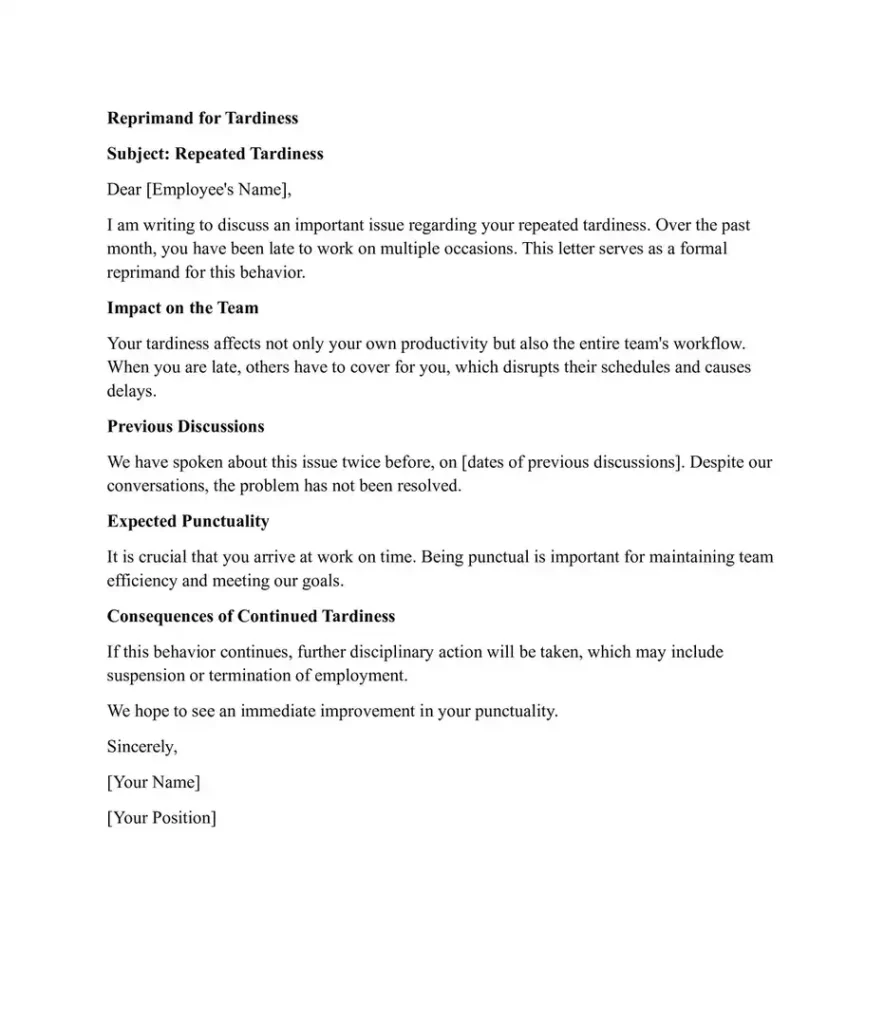
Samples of Reprimand Letters
here is sample reprimand letters:
Reprimand Letter for Disrespectful Behavior
A reprimand letter for disrespectful behavior should:
- List the specific times the employee was disrespectful.
- Explain how this behavior affects the workplace.
- State what behavior is expected in the future.
- Mention any previous warnings or discussions.
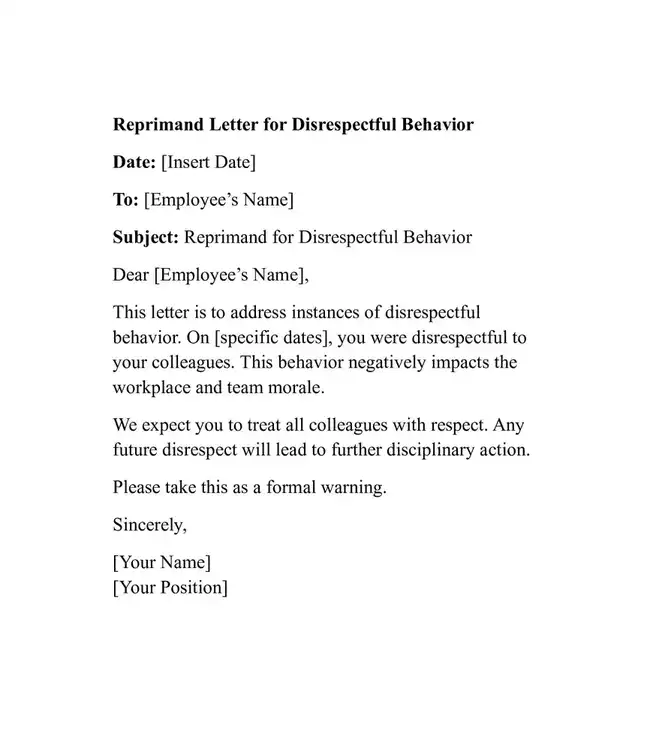
Reprimand Letter for Negligence in Work
This letter should:
- Detail what the employee did wrong or neglected.
- Explain how this affects the team or projects.
- Give clear steps on how to improve.
- Highlight the need for careful and diligent work.
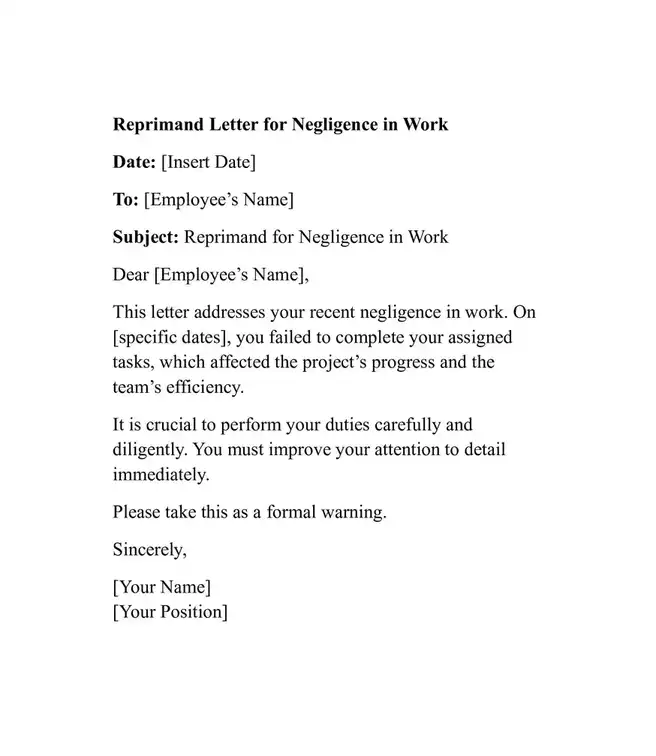
Reprimand Letter for Tardiness
A reprimand letter for tardiness should:
- List the dates the employee was late.
- Describe how being late impacts the team.
- Remind the employee why being on time is important.
- Include any previous warnings and what will happen if lateness continues.

Reprimand Letter for Employee
A general reprimand letter for an employee should:
- Describe the specific issue (behavior, performance, or attendance).
- Explain how the issue affects work.
- State what needs to change and how.
- Provide a timeline for improvement and mention any prior warnings.
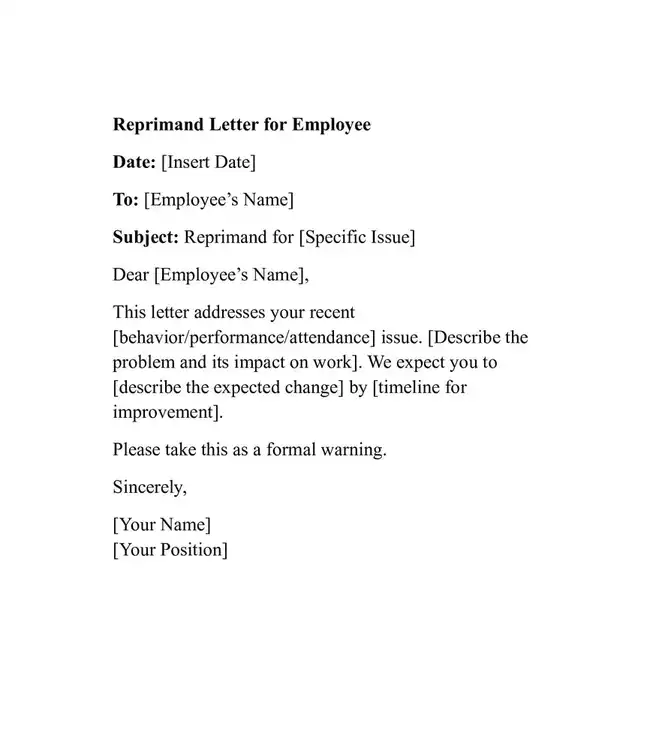
Reprimand Letter for Absenteeism
This letter should:
- List the dates the employee was absent.
- Explain how absences disrupt work.
- Remind the employee of the attendance policy.
- Mention any prior discussions about the issue.

Reprimand Letter for Inappropriate Behavior
A letter for inappropriate behavior should:
- Describe the specific actions that were inappropriate.
- Explain their impact on the workplace.
- Provide guidelines for acceptable behavior.
- Mention any previous warnings and state the consequences if it continues.
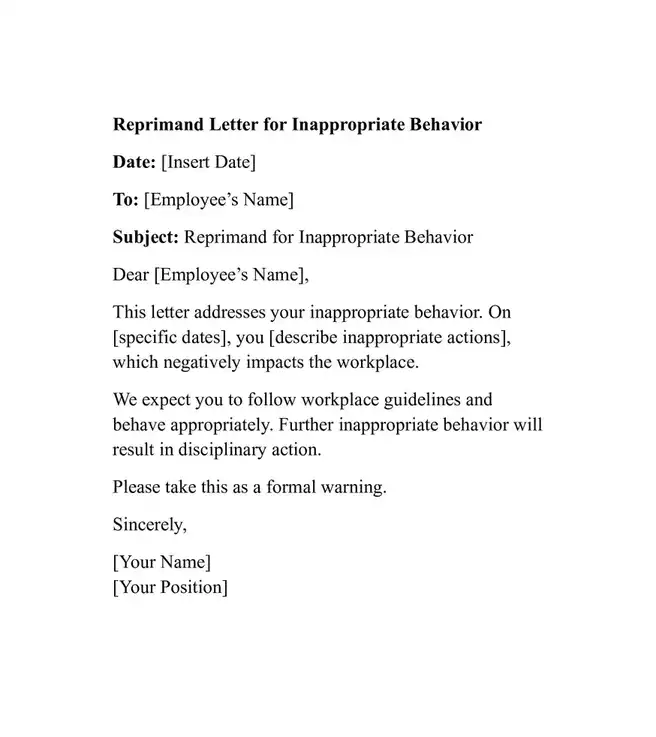
Reprimand Letter for Insubordination
This letter should:
- List the instances of insubordination.
- Describe how these actions violate company policy or disrupt work.
- Stress the importance of following instructions from supervisors.
- Mention any previous incidents and detail the consequences of further insubordination.
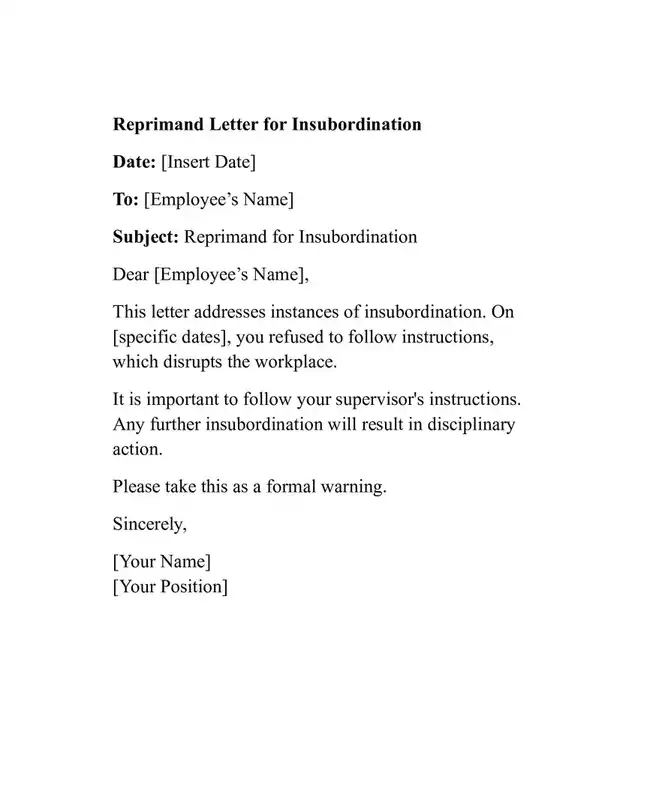
Reprimand Letter for Poor Performance
A reprimand letter for poor performance should:
- Specify the areas where the employee is not meeting expectations.
- Provide examples and explain the impact on the team or company.
- Offer guidance on how to improve and set a timeline for improvement.
- Reference any past performance discussions.
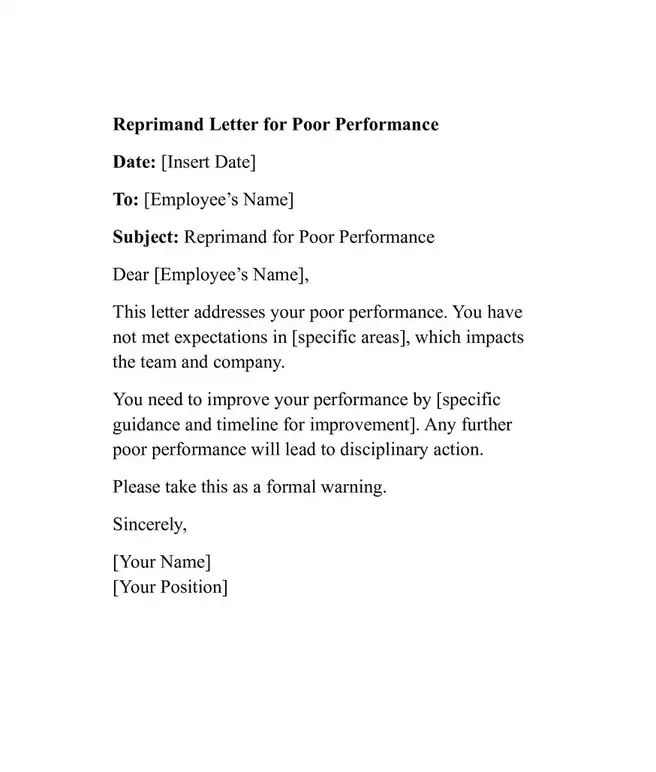
Reprimand Letter for Teacher
This letter should:
- Address specific issues like classroom management, following the curriculum, or interactions with students.
- Explain how these issues affect students and the school environment.
- Provide clear expectations for improvement.
- Mention any prior discussions or warnings.
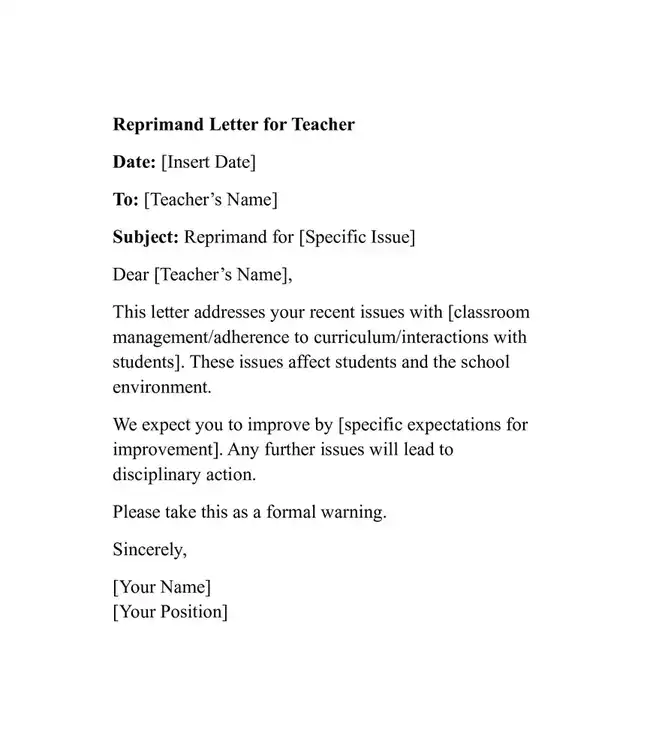
Reprimand Letter for Leaving Work Early
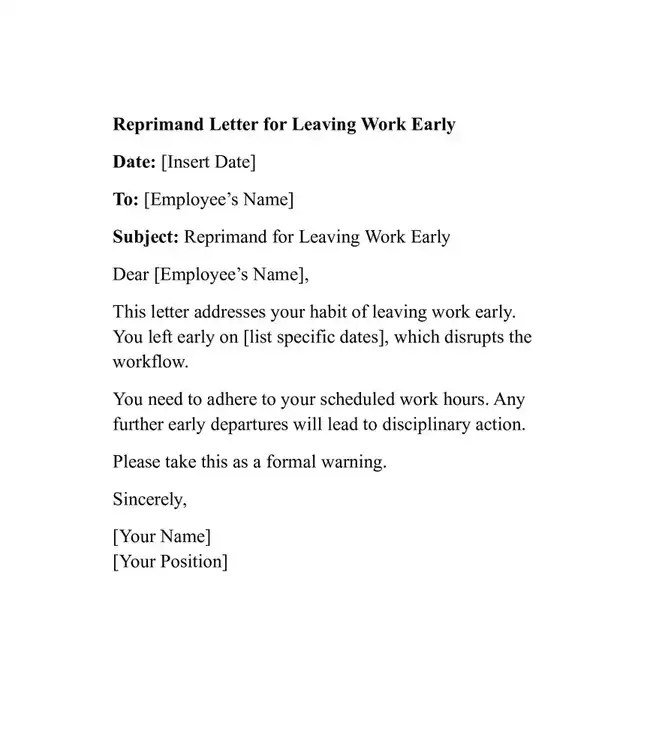
A letter addressing leaving work early should:
- List the dates and times the employee left early.
- Explain how it affects the team or workflow.
- Remind the employee of the work hours policy.
- State the importance of adhering to scheduled hours and outline the consequences of continued early departures.
Reprimand letters are important tools for keeping discipline and making sure employees follow company rules. By understanding how to write them properly, employers can create letters that help employees improve their behavior. Clear communication and helpful feedback are essential for making reprimand letters effective.

Daniel Wilson Is a Seasoned communications professional and letter-writing expert. With over a decade of experience in corporate and non-profit sectors, Has developed a deep understanding of the power of effective communication.
Specializes in creating versatile letter templates that can be tailored to any situation. In this blog, Daniel shares a passion for the art of letter writing, offering practical tips, customizable templates, and inspiring ideas to help you communicate with clarity, confidence, and impact.








